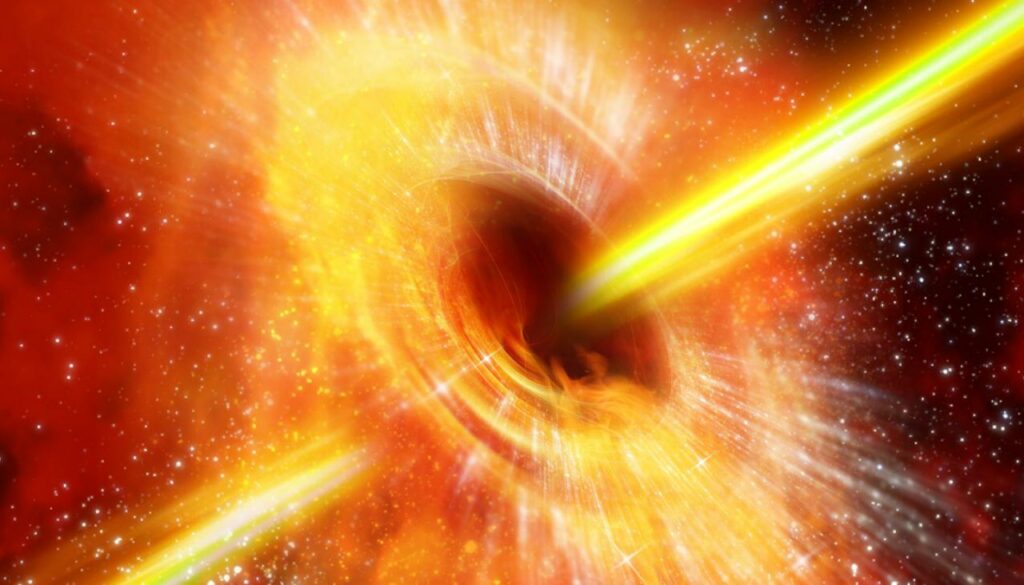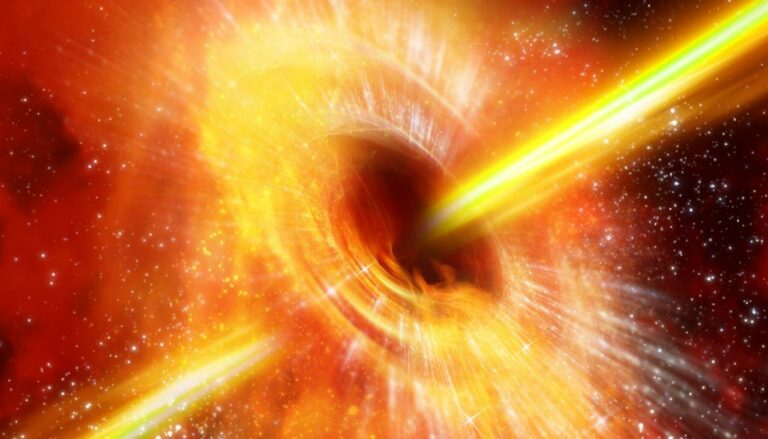Scientists Witness Furthest Tidal Disruption Event in Recorded History, Shedding Light on Black Hole Formation and Early Universe
The universe never ceases to amaze us with its vastness and mysteries. Among the many phenomena that continue to baffle astronomers, the tidal disruption event (TDE) is a unique occurrence that sheds light on how black holes consume celestial objects. When a star gets too close to a black hole, it begins to die in a process called “spaghettification,” which produces a massive energy jet that can be observed from Earth.
Astronomers have recently made a remarkable revelation by witnessing the farthest recorded Tidal Disruption Event (TDE) in history. The incident took place over 12.4 billion light-years away and resulted from a supermassive black hole engulfing a star, creating an energy jet visible through optical telescopes. This discovery offers crucial insights into the development of supermassive black holes and the early universe’s appearance.

The researchers behind the study highlighted the significance of the TDE because the energy jet was collimated, pointing towards our direction, which allowed us to observe it from Earth. This valuable data could help us comprehend the universe’s mysteries better.
The TDE, according to Igon Andreoni, an astronomer from the University of Maryland and co-author of the study, propelled the material jet nearly at the speed of light. This incredible feat of nature is awe-inspiring, reminding us of the universe’s extraordinary power and complexity.
The TDE’s revelation is a tribute to the unyielding commitment of astronomers across the globe who are determined to uncover the universe’s mysteries. Every breakthrough brings us closer to comprehending the cosmos’ evolution and our role in it.
While astronomy has made innumerable strides in discovery, there remains a plethora of knowledge yet to be attained. The boundless expanse of space continues to captivate us, and as new revelations unfold, we are inching closer to unraveling the enigmas of the universe.
The tidal disruption event is an uncommon occurrence that provides astronomers with a unique opportunity to observe a black hole actively consuming a celestial object. As such, it is an important discovery that could help us better understand the universe.
In November 2022, astronomers around the world observed the furthest TDE in recorded history. The event occurred some 12.4 billion light-years away and was caused by a supermassive black hole consuming a star. The resulting energy jet was visible through optical telescopes, allowing scientists to gain valuable insights into how supermassive black holes form and how the early universe appeared.
The study’s authors noted that the event was particularly noteworthy because the jet was collimated, meaning it was pointed in our direction. This allowed astronomers to observe it from Earth, providing valuable data that could help us better understand the universe.
According to Igon Andreoni, an astronomer from the University of Maryland and co-author of the study, “The brilliant material jet was propelled nearly at the speed of light.” This remarkable feat of nature is truly awe-inspiring and reminds us of the incredible power and complexity of the universe.
The discovery of this TDE is a testament to the tireless efforts of astronomers around the world who are dedicated to uncovering the secrets of the universe. With new discoveries like this, we are able to better understand our place in the cosmos and gain insights into the origins and evolution of the universe.
Looking forward, astronomers hope to expand upon their prior discoveries using advanced telescopes such as the Vera C. Rubin Observatory, which will be constructed in Chile. The new observatory will be able to observe the entire visible sky several nights per week, providing a unique opportunity to unveil an entire population of jetted TDEs using optical telescopes.
By revealing a population of such uncommon transients, we can considerably enhance our understanding of the universe’s violence. This would be a significant breakthrough in our understanding of the universe and our place in it.
The universe is vast and mysterious, and it is home to countless phenomena that continue to baffle and inspire us. Among these is the tidal disruption event (TDE), where a star is pulled towards a black hole and undergoes “spaghettification,” a process in which the star’s matter stretches out into long, thin strands. This process releases a tremendous amount of energy, creating an intense jet of radiation that can be seen from Earth. These events provide astronomers with a unique opportunity to study the process of black hole formation and how these celestial giants interact with their surroundings.
Recently, a team of astronomers made an extraordinary discovery when they observed the most distant TDE ever recorded. The event occurred some 12.4 billion light-years away and was caused by a supermassive black hole devouring a star. The resulting energy jet was visible through optical telescopes and provided valuable insights into how supermassive black holes form and evolve over time.
The study’s authors noted that the event was particularly significant because the jet was pointed in our direction, allowing astronomers to observe it from Earth. This provided valuable data that could help us better understand the universe’s origins and evolution. The discovery of this TDE is a testament to the tireless efforts of astronomers around the world, who are dedicated to uncovering the secrets of the universe and expanding our knowledge of the cosmos.
As we delve deeper into the universe and explore its various phenomena, we are constantly reminded of its vastness and complexity. Despite significant advancements in our understanding of the universe over the past few decades, there is still much left to be discovered, especially concerning TDEs.
TDEs offer a rare opportunity to study the formation of black holes and their interactions with their surroundings. Scientists are particularly interested in TDEs because they can provide insight into the universe’s early history. As the universe evolves, supermassive black holes become more prevalent, and studying TDEs can help us comprehend how they develop and change over time. Additionally, TDEs can also help us understand how galaxies evolve, as supermassive black holes are thought to influence the growth of galaxies.
Astronomers are utilizing increasingly sophisticated telescopes and equipment to study TDEs and other cosmic phenomena. The Vera C. Rubin Observatory, which is currently under construction in Chile, is one such instrument that will significantly expand our understanding of the universe. With its advanced capabilities, the observatory will be able to observe the entire visible sky multiple nights a week, revealing an entirely new population of jetted TDEs.
In conclusion, the discovery of the furthest TDE in history is significant and provides valuable insights into the early universe’s appearance and the formation of black holes. By studying these phenomena, astronomers can gain a better understanding of the universe’s origin and evolution, and we inch closer to unraveling the cosmos’ mysteries.
Source:Research Article
Do not forget to share your opinion with us to provide you with the best posts !




0 Comments